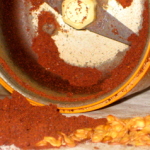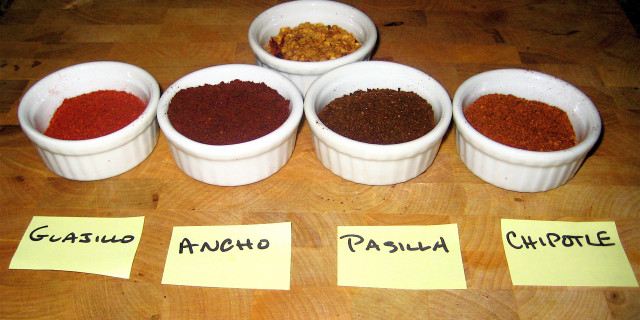I am all about little things, quick things, ridiculously simple things that add huge amounts of flavor to food, whether you’re doctoring up store bought food or goosing the flavor of your own homemade standbys. These little tricks, ingredients and tweaks are not just the property of restaurant chefs, they belong to home cooks too. Dried chiles are one of these simple things I turn to often to make life in the kitchen easy. (Spelling chiles may not be so easy. I stick with the Spanish word “chile” and its plural “chiles” when talking about the pepper and “chili” when talking about the dish.) Dried chiles, like all dried fruit—raisins, cherries and so on—can last a while, but not forever. Buy them in small amounts from someplace that sells a lot of them. A few doors down the street from our old apartment is a tiny place called El Paso Grocery where I buy my dried chiles. They sell some kinds loose and some in small plastic bags. I usually bring home a boatload for less than 10 bucks. Always look for whole, pliable chiles with the stems on. You don’t use the stems, but intact chiles are usually better quality than those that are sold in scraggly little pieces.
Each type of dried chile has its own level of heat, fruitiness, earthiness and its own distinct flavor. There are so many types of dried chiles available that books can and have been written about them. My favorite all-chile book is Jean Andrews’s Red Hot Peppers which not only describes just about every type of fresh and dried chiles and gives recipes for them, but traces the migration of chiles around the world to boot. I eat that kind of stuff up with a spoon. Who knew Arab traders introduced chiles to the all-Bhuddist island of Ceylon in 1540?
My favorite all-chile person is Roberto Santibañez, Mexican cooking expert and one hell of a cook. I met Roberto when we worked together on a book, Rosa’s New Mexican Table. Roberto is passionate about the food of his native Mexico and about bringing it to everyone in the world. No, really, everyone. His mother is a cultural anthropologist who focuses much of her studies on food and cooking and a lot of that has seeped into Roberto’s being. He cannot tap the seeds out of a chile, smell a chile cooking, or grind a toasted chile to a brick-red powder without commenting on its origins, how it might have popped up in this particular dish or what was its name in the Maya tongue. He has taught me a lot about dried chiles, which I use in traditional and not so traditional ways.
In the American spirit of gross over- simplification, I will say that dried chiles are used in two main ways: First, they are toasted, ground to a powder in a spice mill (in the photo above, chile seeds are behind the powders) and used to season raw and cooked food. Second, they are toasted, SOAKED, and then ground or pureed with other ingredients in a stew, salsa, marinade or sauce.
Most of what you see in a supermarket labeled “chili powder” is a blend of stuff, including some type of ground chile, but also oregano, cumin, salt, garlic powder and possible other things. It is “chili powder” in the sense that it is meant to season a pot of chili, not that it is made strictly from powdered chiles. More often now you will see bottles labeled “pure chile powder” which means they contain nothing but dried, toasted and ground chiles–usually exclusively one variety of chile, the name of which is on the label: ancho chile powder, chipotle chile powder, etc. It is very easy to make your own pure chile powders. First pick a chile: Of the four pictured above, guajillo is probably the mildest followed by pasilla and ancho in a close tie, with chipotle being the most fiery. Then again, just like with fresh chiles, you kind of have to take the heat chile by chile. Side note: chipotle is one of those culinary buzz words like “fire grilled” being thrown around loosely today. (What else are you going to use to grill something? Ice? Damp hay?) But chipotle actually means something. It is a jalapeño that has ripened and turned red, then is dried and smoked slowly. So not only do you get the kick from the heat, you get an incredibly deep, rich, smoky flavor. With chipotles, a little goes a long way.
Next, toast the chiles—in a pan or griddle over low heat or on a baking sheet in a 350° oven. Turn them often so they cook evenly and don’t burn How long this will take depends on the chiles. Pasillas and anchos will toast in a minute or two. Some chiles, chipotles for instance, take longer. The chiles are done when they change color, blister in a place or two and smell wonderful. For my money, there are few things on earth that smell as delicious as chipotles toasting on a griddle. Let them sit for a minute, pull off the stems and tap out the seeds. Roberto says that Mexican cooks save all the seeds from different kinds of chiles, then toast them a little, grind them, and use the powder for rubs and seasonings. I think they would be a great addition to homemade Italian pork sausage. Let the chiles cool off. They should turn brittle as they cool, that’s when they’re ready to grind. If they’re not brittle, pop them in a 350° F oven for 3 or 4 minutes and they’ll be good to go. A little spice mill/coffee grinder that is dedicated to blitzing spices is ideal for grinding.
So, you’ve got one or two kinds of dried chiles on hand and 10 minutes later they have been toasted and ground. Not bad. Now the fun begi ns. Use your chile powder anyplace you would use black pepper for a kick–soups, sauces, salad dressings, marinades and rubs for starters. Go easy at first, freshly ground chile powder, even when it’s made from fairly mild chiles like guajillos, is more flavorful–not just more spicy–than the tame store bought variety. They also have a tendency to come on strong if the marinade or dressing sits for a bit. Longer sitting or cooking will tend to mellow them a bit. Chipotle powder, in miniscule additions, makes a kickass bloody Mary. Or make a melon/pineapple salad and, just before serving it, sprinkle a little ancho or pasilla powder over it, along with a little coarse salt and a squeeze or two of limes. The simplest way to prove the power of the powder is to make a favorite recipe that calls for “chili powder” with the freshly toasted and ground chile of your choice.
ns. Use your chile powder anyplace you would use black pepper for a kick–soups, sauces, salad dressings, marinades and rubs for starters. Go easy at first, freshly ground chile powder, even when it’s made from fairly mild chiles like guajillos, is more flavorful–not just more spicy–than the tame store bought variety. They also have a tendency to come on strong if the marinade or dressing sits for a bit. Longer sitting or cooking will tend to mellow them a bit. Chipotle powder, in miniscule additions, makes a kickass bloody Mary. Or make a melon/pineapple salad and, just before serving it, sprinkle a little ancho or pasilla powder over it, along with a little coarse salt and a squeeze or two of limes. The simplest way to prove the power of the powder is to make a favorite recipe that calls for “chili powder” with the freshly toasted and ground chile of your choice.




